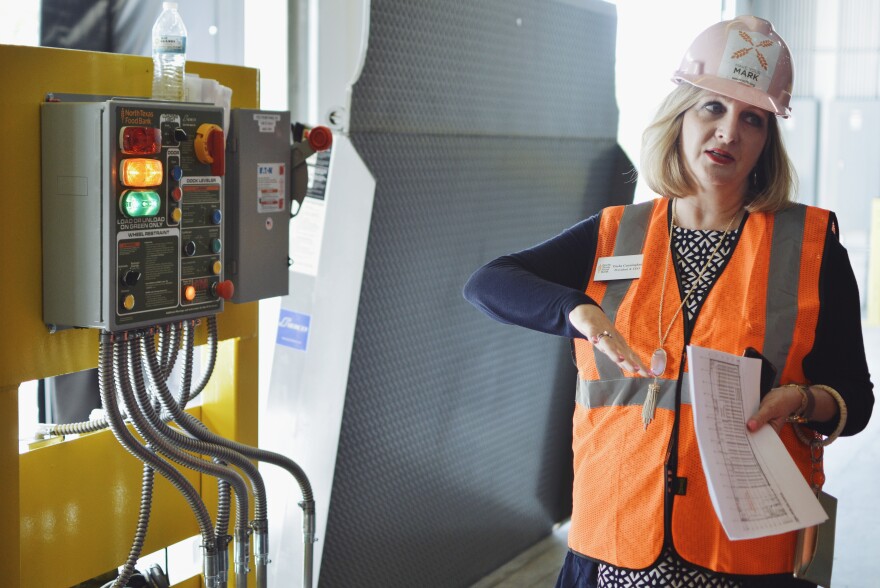At the North Texas Food Bank’s brand-new distribution center in Plano, there’s a community garden, a volunteer orientation center and massive stock rooms, with long corridors of towering metal shelves. It’s like wandering through a Costco or a Sam’s Club.
When the 230,000-square-foot facility off President George Bush Turnpike and Coit Road opens next month, CEO Trisha Cunningham says the food bank will be even closer to hitting a major milestone: serving 92 million meals a year by 2025. She says moving north gives them a geographical advantage.
“We serve people up to the Oklahoma border, Grayson County, all the way down to Ellis County, out east towards Kaufman, Delta County [and] Hopkins County,” she said. “So we serve urban, suburban and rural areas, and where we’re at is right in the sweet spot of being able to be central to [those] 13 counties.”
Overall, the new facility doubles the food bank’s previous storage capacity. And the fridge and freezer triples its cold storage for fresh produce, dairy and meat, which Cunningham says is important because food banking is changing.
“Back in the early days of food banking, they were doing rescue of any kind of food. They were taking cookies and candy and anything that anyone wanted to give us,” she said. “But then I think the conscious of the food bank was, ‘If we're going to feed hungry people, it's not just about putting food in their stomach. It's about trying to make sure that they have a better quality of life as a result of what we're able to provide them.’”

That’s not all that’s changing in food banking. Moving to Plano is a signal that the face of hunger is changing, too. Collin County is one of the wealthiest in Texas, with a median household income of nearly $90,000. Plus, the Plano-Frisco areas have become hubs for economic development, but the region’s affluence has left many behind.
“When a region sees huge, rapid growth, food insecurity sometimes tends to follow,” said Sejal Desai, business engagement director for the Communities Foundation of Texas for Business and a member of the Indo-American Council at the North Texas Food Bank.
According to Feeding America, about 15 percent of Collin County residents don’t know when or from where they'll get their next meal. That’s only three percentage points lower than in Dallas County. And of those who are food insecure in Collin County, more than a third are children.
"Hunger has no zip code."
“Interestingly enough on the map, the southwest parts of Collin County seem to have a stronger food insecurity rate almost going up to 30 percent of the households there,” Desai said.
That’s right in the core of Plano — all along George Bush Turnpike from the Dallas North Tollway to Central Expressway. The food bank’s new facility sits on that stretch of highway.
It’s not a part of North Texas people commonly associate with hunger, but “hunger has no zip code,” says Cheryl Jackson, who founded Minnie’s Food Pantry in Plano, which is one of the North Texas Food Bank’s many local partners.

Jackson has been trying to raise the profile of the food insecure in Plano for the past decade.
“When we apply for grants, literally when we put our ZIP code, they say we’re in a wealthy area and sometimes we're not even given the opportunity to get grants to feed the hungry because Plano is considered to be so affluent,” she said.
But Jackson says she sees nearly 150 new families on average show up at Minnie’s every month. In 10 years, they’ve served 8 million meals, and they've already distributed more than 800,000 as of August of this year. She says hunger isn’t the homeless person begging on the streets anymore. It’s the person in the cubicle next to you or the the single mother trying to pay for day care.

“We see Hummers pull up with 26-inch rims on them, and when I sit and hear their stories, the story is: ‘I was in Corporate America, but my salary got cut in half,’ or ‘I lost my job and we were living at our means, and now this car is probably going to be our home because we are so far upside down.’
“So the face of hunger has been our cry,” Jackson said. “It has changed.”
Jackson says there’s no real resolution to this degree of hunger; there’s only awareness, with the hope it leads to help and action. She says seeing the North Texas Food Bank in Plano will help people better understand how close hunger hits.
The Communities Foundation of Texas is a financial supporter of KERA's One Crisis Away Initiative.



